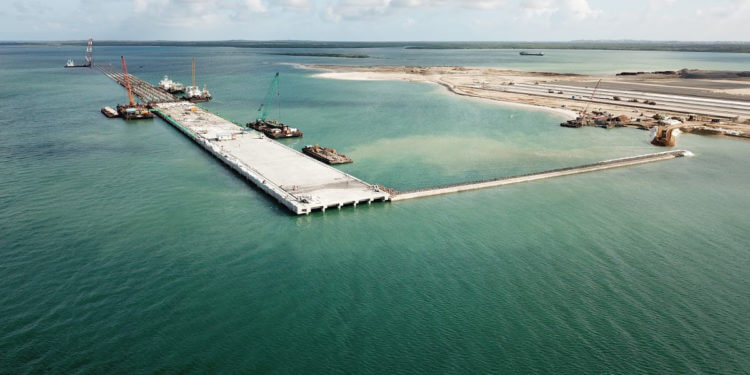
Our Projects are
Transforming African Trade
Quick Contacts
2nd Floor, Fidelity Insurance Centre Waiyaki Way, Westlands

The First Berth at Lamu Port was completed last year together with a container yard with a holding capacity of over 21,000 TEUs.
he government’s lock-down of the ongoing construction sites at Lamu port when the country recorded the first cases of Covid 19 has paid off after the contractor completed 2 more berths recently – five month earlier. This now brings the total number of completed berths to 3.
The Lamu Port South Sudan Ethiopia Transport (Lapsset) authority Director General Silvester Kasuku told a TV talk show this week that the authorities did not allow anyone to leave the site or gain its entry. Anyone who left for whatever reason was not accommodated back, he said.
But the date of commissioning is still unknown, Kasuku said.
“The first berth has been ready since last year, but the itineraries of the three Head of States involved in the project did not coincide, causing the delay in its commissioning,” Mr Kasuku was recently quoted by the press in Kenya.
The First Berth at Lamu Port was completed last year together with a container yard with a holding capacity of over 21,000 TEUs. The berth was due for commissioning last year with Maersk Shipping Line having committed to call in the first vessel. This was, however, postponed and the situation has even been made complex by the Covid 19 pandemic.
The other supporting infrastructure projects such as the causeway, aids to navigation, security requirements including fencing of the yard and International Ship and Port Facility Security Code (ISPS) compliance as well the ongoing deployment of staff and equipment have been done.
“As Kenya Ports Authority (KPA), we can confirm that we are ready to do business at Lamu Port. We have been able to gazette the port as customs area and allocated an area for a temporary warehouse as well as mark another area for transshipment cargo which is what we are encouraging in the initial period of our operations,” KPA said in an email interview before coronavirus was reported in Kenya, adding that staff from Kenya Revenue Authority (KRA), Kenya Bureau of Standards (KEBS) and Port Health among other key agencies involved in cargo clearance have already been posted to Lamu.
In addition, 10 KM dual carriageway road linking the port to the main highway is complete. The construction of the Lamu – Garsen – Witu road has also registered tremendous progress.
This existing road can be used for the early evacuation of cargo from the port with shippers having a choice to either take their cargo through Garissa – Thika Nairobi or via Malindi.
The LAPPSET Corridor’s main transit market is South Sudan and Ethiopia. The 505KM Lapsset Highway from Isiolo to Moyale was completed over 4 years ago and has significantly transformed transportation enabling faster and cost-effective movement of goods and people along the new corridor.
This is expected to be connected to Lamu via the 536KM Lamu – Garissa – Isiolo highway hence interconnecting the region, spurring regional trade and enhancing economic development, KPA said.
Detailed engineering designs of this project were completed. KPA reported that the World Bank approved a 500 million USD loan for the construction of the section from Lokichor and Nakadok ultimately linking Kenya to Juba South Sudan.
Though the initial target of the new port is transshipment cargo, the second commercial port in the country will also play a complementary role to Mombasa Port. This shall provide an alternative route or option for shippers who might want to take advantage of the promotional tariff and revive the transportation sector.
“We also hope and shall continue to encourage business communities of Northern region’s counties of Garissa and Isiolo and of course Lamu to import and export their goods including livestock and fish through this port” KPA said, adding that Lamu has also a great potential for Cruise Tourism.
Ultimately, and with a good road infrastructure in place, Kenya expects to undertake a deliberate marketing initiative to lure transit countries of Ethiopia and South Sudan which is the main objective of opening the new LAPSSET Corridor.
When the project was conceived over a decade ago, the project consultants, in their concept paper, identified six components of the project. In order to become a transportation and commercial hub for the region, Kenya would have to, at a minimum, develop: (a) a commercial port of international standards capable of handling high volumes of containers and other goods traffic; (b) a free trade zone along with the port to foster the growth of trade and commercial activity to make the area a commercial hub; (c) a new beach resort city having facilities of international standards for native and international tourists; (d) an airport capable of being an air hub for the region; (e) a railway network to enable movement of goods from the port and the free trade zone to other parts of Kenya and the countries of the region; and (f) a road highway network to support the capacity of the railway network and provide for greater movement of goods into more areas.
All these are still in the pipeline. However, special priority has been given to the Port, Highways, Pipeline and Special Economic Zones.
Read the original article
Disclaimer: The opinions expressed herein are the author’s and not necessarily those of TradeMark Africa.
Disclaimer: The views and opinions expressed in this article are those of the authors and do not necessarily reflect the official policy or position of TradeMark Africa.